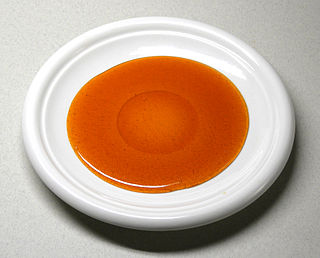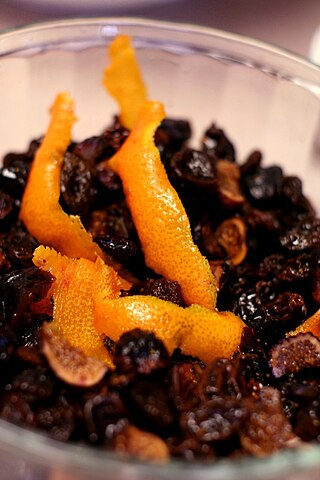
Dessert is a course that concludes a meal. The course consists of sweet foods, such as cake, biscuit, ice cream and possibly a beverage such as dessert wine and liqueur. Some cultures sweeten foods that are more commonly savory to create desserts. In some parts of the world there is no tradition of a dessert course to conclude a meal.

A berry is a small, pulpy, and often edible fruit. Typically, berries are juicy, rounded, brightly colored, sweet, sour or tart, and do not have a stone or pit, although many pips or seeds may be present. Common examples of berries in the culinary sense are strawberries, raspberries, blueberries, blackberries, white currants, blackcurrants, and redcurrants. In Britain, soft fruit is a horticultural term for such fruits.

Calamansi, also known as calamondin, Philippine lime, or Philippine lemon, is a citrus hybrid cultivated predominantly in the Philippines. It is native to the Philippines, parts of Indonesia, Malaysia, and Brunei, as well as parts of southern China and Taiwan.

Caramel is a confectionery product made by heating a range of sugars. It is used as a flavoring in puddings and desserts, as a filling in bonbons or candy bars, or as a topping for ice cream and custard.

The jackfruit is a species of tree in the fig, mulberry, and breadfruit family (Moraceae). The jackfruit is the largest tree fruit, reaching as much as 55 kg in weight, 90 cm in length, and 50 cm (20 in) in diameter. A mature jackfruit tree produces some 200 fruits per year, with older trees bearing up to 500 fruits in a year. The jackfruit is a multiple fruit composed of hundreds to thousands of individual flowers, and the fleshy petals of the unripe fruit are eaten.

A soufflé is a baked egg dish originating in France in the early 18th century. Combined with various other ingredients, it can be served as a savoury main dish or sweetened as a dessert. The word soufflé is the past participle of the French verb souffler, which means to blow, breathe, inflate or puff.

Spumoni is a molded gelato made with layers of different colors and flavors containing candied fruits and nuts, with the main three flavors being pistachio, cherry, and chocolate. Its origins date back to the end of the 19th century in the Italian city of Naples, Campania.
Nix v. Hedden, 149 U.S. 304 (1893), is a decision by the Supreme Court of the United States in which the Court unanimously held that tomatoes should be classified as vegetables rather than fruits for purposes of tariffs, imports and customs. Justice Horace Gray delivered the opinion of the Court in holding that the Tariff Act of 1883 used the ordinary meaning of the words "fruit" and "vegetable", instead of the technical botanical meaning.

Peach Melba is a dessert of peaches and raspberry sauce with vanilla ice cream. It was invented in 1892 or 1893 by the French chef Auguste Escoffier at the Savoy Hotel, London, to honour the Australian soprano Nellie Melba.

Maceration is the process of preparing foods through the softening or breaking into pieces using a liquid.

A garnish is an item or substance used as a decoration or embellishment accompanying a prepared food dish or drink. In many cases, it may give added or contrasting flavor. Some garnishes are selected mainly to augment the visual impact of the plate, while others are selected specifically for the flavor they may impart. This is in contrast to a condiment, a prepared sauce added to another food item primarily for its flavor. A food item which is served with garnish may be described as being garni, the French term for "garnished."

A purée is cooked food, usually vegetables, fruits or legumes, that has been ground, pressed, blended or sieved to the consistency of a creamy paste or liquid. Purées of specific foods are often known by specific names, e.g., apple sauce or hummus. The term is of French origin, where it meant in Old French purified or refined.
A mechanical soft diet or edentulous diet, or soft food(s) diet, is a diet that involves only foods that are physically soft, with the goal of reducing or eliminating the need to chew the food. It is recommended for people who have difficulty chewing food, including people with some types of dysphagia, the loss of many or all teeth, pain from recently adjusted dental braces, or surgery involving the jaw, mouth, or gastrointestinal tract.

Fruit preserves are preparations of fruits whose main preserving agent is sugar and sometimes acid, often stored in glass jars and used as a condiment or spread.

A bombe glacée, or simply a bombe, is a French ice cream dessert frozen in a spherical mould so as to resemble a cannonball, hence the name ice cream bomb. Escoffier gives over sixty recipes for bombes in Le Guide culinaire. The dessert appeared on restaurant menus as early as 1882.

This is a categorically organized list of foods. Food is any substance consumed to provide nutritional support for the body. It is produced either by plants, animals, or fungi, and contains essential nutrients, such as carbohydrates, fats, proteins, vitamins, and minerals. The substance is ingested by an organism and assimilated by the organism's cells in an effort to produce energy, maintain life, or stimulate growth.
Fruktsoppa is a fruit soup that is typically prepared using dried fruits, and usually served as a dessert dish. The dish has been described as a "cold fruit pudding." It is a traditional dessert in Sweden and Norway. Historically, during the winter months in Scandinavian countries, fresh fruit was generally unavailable, so people used dried fruits for the preparation of various dishes, including fruktsoppa. The soup may be served hot or cold. The soup can be made with one fruit or with multiple fruits; a soup which is made with multiple fruits may be called blandad fruktsoppa, which is Swedish for "mixed fruit soup".
















